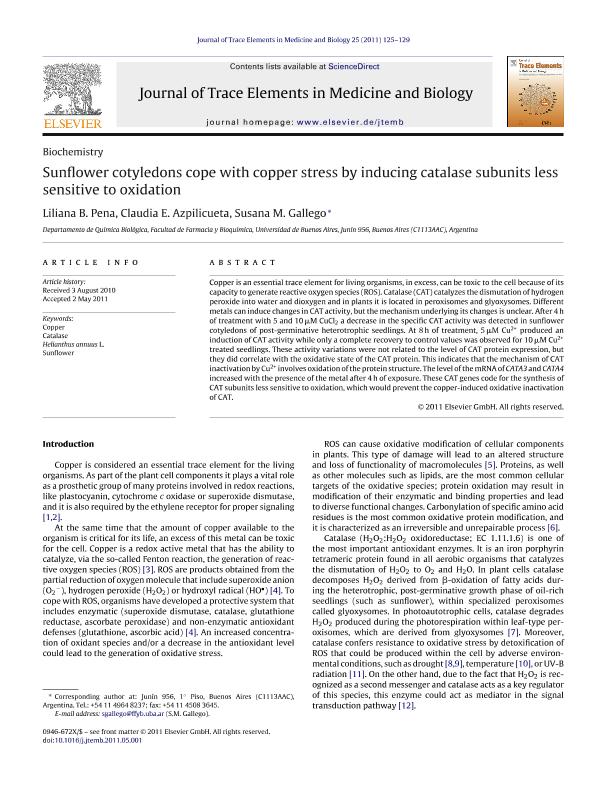Artículo
Sunflower cotyledons cope with copper stress by inducing catalase subunits less sensitive to oxidation
Fecha de publicación:
07/2011
Editorial:
Elsevier Gmbh
Revista:
Journal of Trace Elements in Medicine and Biology
ISSN:
0946-672X
Idioma:
Inglés
Tipo de recurso:
Artículo publicado
Clasificación temática:
Resumen
Copper is an essential trace element for living organisms, in excess, can be toxic to the cell because of its capacity to generate reactive oxygen species (ROS). Catalase (CAT) catalyzes the dismutation of hydrogen peroxide into water and dioxygen and in plants it is located in peroxisomes and glyoxysomes. Different metals can induce changes in CAT activity, but the mechanism underlying its changes is unclear. After 4 h of treatment with 5 and 10 μM CuCl2 a decrease in the specific CAT activity was detected in sunflower cotyledons of post-germinative heterotrophic seedlings. At 8 h of treatment, 5 μM Cu2+ produced an induction of CAT activity while only a complete recovery to control values was observed for 10 μM Cu2+ treated seedlings. These activity variations were not related to the level of CAT protein expression, but they did correlate with the oxidative state of the CAT protein. This indicates that the mechanism of CAT inactivation by Cu2+ involves oxidation of the protein structure. The level of the mRNA of CATA3 and CATA4 increased with the presence of the metal after 4 h of exposure. These CAT genes code for the synthesis of CAT subunits less sensitive to oxidation, which would prevent the copper-induced oxidative inactivation of CAT.
Palabras clave:
Copper
,
Catalase
,
Helianthus Annuus L
,
Sunflower
Archivos asociados
Licencia
Identificadores
Colecciones
Articulos(IQUIFIB)
Articulos de INST.DE QUIMICA Y FISICO-QUIMICA BIOLOGICAS "PROF. ALEJANDRO C. PALADINI"
Articulos de INST.DE QUIMICA Y FISICO-QUIMICA BIOLOGICAS "PROF. ALEJANDRO C. PALADINI"
Citación
Pena, Liliana Beatriz; Azpilicueta, Claudia Elsa; Gallego, Susana Mabel; Sunflower cotyledons cope with copper stress by inducing catalase subunits less sensitive to oxidation; Elsevier Gmbh; Journal of Trace Elements in Medicine and Biology; 25; 3; 7-2011; 125-129
Compartir
Altmétricas




